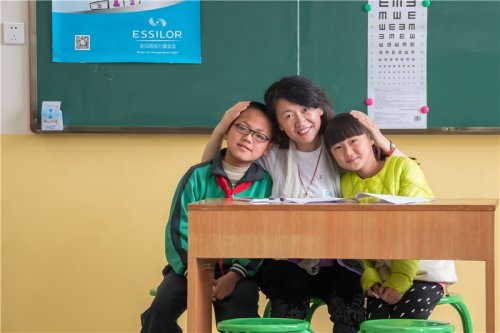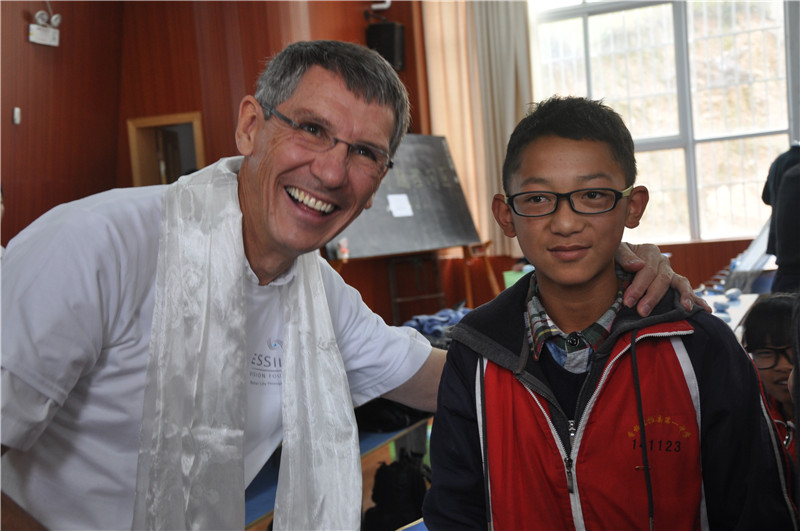Essilor: Driving Continuous Innovation with CSR

Established in Paris in 1849, Essilor is a global innovator and leader in ophthalmic optics.
Essilor has innovation at its core. In 1959, Essilor created the world’s first progressive lenses, and in that same year the first organic lenses were produced at Essilor, which laid the foundation for the group’s leadership position within the industry. Thanks to a strategy of technological innovation, over the past 170 years Essilor has expanded its business from Paris to over 100 countries and regions around the world. Since going public in 1975, the company has maintained double-digit growth and its stock price has grown about 400 times since its IPO. Over the years, Essilor has been continuously increasing its investment in R&D, with more than €200 million dedicated to research and innovation each year and a global R&D team of 550. As at the end of 2017, Essilor owned 8,065 patents. Persistence in R&D and innovation has brought about generous returns to the company. Now 40% of the group’s revenue is generated by the new products launched over the last four years.
Essilor’s ‘innovation genes’ can be successfully passed from one generation to the next because the company not only executes a strategy of technological innovation in its operations and management, but also creates value for society through new business models in order to fulfil its mission of improving lives by improving sight. Essilor is also a global pioneer in employee shareholding and representatives of its Valoptec Association are members of the Group’s Board of Directors. This system is effective in enhancing shareholders’ dignity and giving them a sense of belonging. By ensuring that employees have a say during board meetings and take part in the company’s operation and management, the company culture of innovation and social responsibility is actively disseminated throughout the Group.
CSR as an Engine for Innovation
For more than a century, Essilor has been battling the global challenge of poor eyesight. It is estimated that about 2.5 billion people are suffering from vision problems that have gone uncorrected. Faced with such a huge demand, it is obviously not enough to merely provide vision-correcting products because many of these people reside in underdeveloped regions, which means product price and accessibility are their greatest obstacle.
In 2013, Essilor Group established a department tasked to fulfil its mission of improving lives by improving sight. One of the resulting initiatives was the 2.5 New Vision Generation Division’s vision ambassadors, an innovative project aimed at helping poor-sighted people in underdeveloped regions. The project adopts a social enterprise model, recruiting and training vision ambassadors. Through basic service offered by these ambassadors, it checks the vision of people in need among the rural elderly and within poverty-stricken communities, then provides high-quality and inexpensive glasses, so as to improve their quality of life. After rounds of training, vision ambassadors gradually grow into professionals who sell reading- and sun glasses, which promises them a steady source of income that also drives consumption within the community and pushes forward local economic development.
The model has also triggered higher product demand. In order to provide affordable and easily delivered products, revolutionary ‘ready-to-clip’ glasses were born. These are clip-on prescription lenses with specially-designed brackets that can clip onto existing frames. Vision ambassadors check villagers’ eyes then clip suitable lenses onto the brackets, a quick and easy way to adjust their prescriptions without the need for new glasses. With this inexpensive, high-quality product, many elderly villagers’ far-sightedness can immediately be corrected, greatly improving their everyday life. At the same time, the company has opened up a new market and is reaping the benefits of a new opportunity for sustainable development.
Essilor’s 2.5 New Vision Generation project was first rolled out in China then expanded to parts of India. It has not only created job opportunities and improved overall vision health but also brought about long-lasting social and economic benefit for the communities involved.
In 2016, Essilor officially registered its Essilor Vision Foundation in China. The foundation is aimed at harnessing and leveraging the love and expertise of the entire industry to build an open public good platform focused on vision health, promising a clearer and better world for Chinese kids via vision health education, vision screening and glasses prescription.
China is one of the countries that suffer from the highest levels of short sightedness in the world. According to industry reports, China has 450 million people – one in every three – suffering from short sightedness. Faced with such a huge group, it is impractical to rely on one enterprise or institution. This is why Essilor, by setting up public good platforms via the foundation, has continuously encouraged its staff, joint ventures in China and partners in the upstream and downstream supply chains to be part of the solution. With this approach, it has transferred the idea of responsibility to a greater number of enterprises.
In 2014, Essilor and Aier Eye Hospital jointly initiated Eye Do, a public good programme focused on vision health in juveniles. This is a long-term project. Thanks to Aier Eye Hospital’s professional medical team and Essilor’s hundreds of years of experience in ophthalmic optics, needy Chinese students receive free vision screening, related eye-care training, and prescriptions. As of the end of 2017, about 500,000 primary school students had been screened and 27,000 kids from needy families had received free prescription eye-glasses through the project. The initiative received the Annual Pubic Interest Programme Award during the 5th China Charity Festival.
“My biggest takeaway from the experience was the switch in roles – I went from being a staff member who’s versed in interpreting product knowledge, to a teacher who imparts eye-care knowledge to kids,” said a member of Essilor’s sales team who volunteered with the foundation. “In this process, there is no product promotion or marketing but only pure love and responsibility.”
Essilor’s CSR Strategy
Exclusive interview with Hubert Sagnières, Chairman and CEO of Essilor International, Member of CEIBS IAB

TheLINK: In your role as the CEO and as a member of the CSR committee of Essilor International, how do you ensure that the company’s CSR efforts are aligned with its overall strategy?
Hubert Sagnières (HS): CSR is, of course, a must-have. But more importantly, it needs to be part of a wider plan, an ambition, of what is driving a corporation’s strategy. A lot of companies see CSR as just ticking a box.
I think the more important point is: what is the purpose of the company. In our case, since Essilor was born, we have one purpose, which is improving lives by improving sight. Essilor has been leading the optical industry by constantly inventing and improving vision solutions and providing eyeglasses so as to improve the vision of everyone in the world. As a leader, it is our responsibility to raise awareness on the importance of vision and keep innovating to provide products and solutions that enable people to have better access to vision care. There are 7.5 billion people on the planet today. There will be close to 10 billion by 2050. We want them all to see well so they can have a great life. That’s why we have made it our goal to eradicate poor vision by 2050. And this is how, as a corporation, we see our responsibility. Our mission and our ambition drive our overall strategy.
I think what is most important when you are leading a company like ours is to define and share your purpose. Being aware of what makes you, as an employee of Essilor, very proud to come to work every day, for example, is key to engagement. And CSR is one component of it. In our case, we are defined, beyond CSR, by our mission and our goal of eradicating poor vision in one generation.
TheLINK: What are some of the ways in which Essilor China uses CSR to impact people’s lives?
HS: Out of around 7.5 billion people in the world there still are, unfortunately, 2.5 billion people who don’t see well. And around 500 million of them live in China. They either can’t afford eyeglasses or they don’t have access to eye care professionals and to the solutions they need to see well.
So in China we are developing our mission-led initiatives under two key pillars. The first, the Essilor Vision Foundation, covers all of our charitable activities, including various events where we provide eye checks and eyeglasses to people in need.
But this is never enough.
To fulfil our mission in China, the most important part of CSR actions on the field is Social Impact Business. This is really what will change the world. We identify young talents in remote places whom we train, we empower, to enable them to do eye tests and deliver reading glasses to their community. And it is a business in the sense that we are selling a pair of eyeglasses for basically RMB10 - 15 and then it is sold for RMB30 - 40 to low-income people. And everyone at every step of the chain is making money. This is the type of programme, a new social impact business model, which is the most promising in China and in many countries around the world. In fact, we need both kind of programmes. We need charitable activities and also social impact activities that aim at being sustainable.
TheLINK: CSR is also vital to CEIBS – from the school’s leadership to our student-led initiatives. Do you have any suggestions on what more CEIBS could do to become even more socially responsible?
HS: I have a dream for CEIBS, as a business school. In leading in the training of all those young and mid-age top executives that will lead Chinese corporations in China and other companies around the world, CEIBS needs to really start developing courses on leading with a purpose. In the next 15 years, successful corporations will not be based on the same economic models that we had the past 15 - 20 years. What I learnt in business school 40 years ago was good for the past. Now, we need to teach how to lead with purpose. Business executives need to be able to, with their core team, determine the purpose of their corporation, define their strategy around this purpose and develop a model that will have an impact on the world, while at the same time being financially and economically very strong – because both go together. I think CEIBS should lead this initiative.















